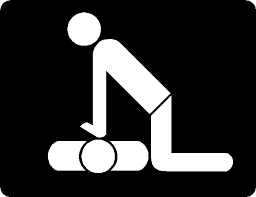Patch A Radiator Hose
A temporary fix, but an important one none the less.

Wait for the engine to cool off. Open the hood and locate the source of the steam—i.e., the rupture (A). Clean and dry the area around the fissure; the tape won’t stick as well on a damp, dirty surface.
Wrap 2 to 3 in. of duct tape around the hose over the hole; press firmly (B).
Overwrap the patch (the hose will be under intense pressure) from 2 to 3 in. above the original piece to about 2 or 3 in. below, then work your way back (C). Check your radiator level before cranking the engine. “If it’s seriously low and you don’t have a can of coolant, use water or, in an emergency, diet soda,” says Tony Molla of the National Institute of Automotive Service Excellence and former pro wrench jockey. “Avoid using fruit juice or anything with sugar or acids in it. It’ll corrode the radiator and hoses.”
Back Up a Trailer (sin spotter)
Because someone might not always be there to guide you!

If you’re doing this without a spotter, put your left hand at six o’clock on the steering wheel, and drape your right hand over the seatback. As you back up, move your steering hand in the direction you want the trailer to go.
Perform CPR
You just never know.

Phone for help, then look and listen for the victim’s breathing. Open the airway by tilting the head back and lifting the chin so the teeth almost touch.
Pinch both nostrils closed; bend your head over his face and fully cover his mouth with yours. Give two full rescue breaths, making sure to breathe deeply.
Place your dominant hand on the middle of the victim’s chest. Put your other hand on top and interlock your fingers. Straighten your arms and begin compressing the chest 112 to 2 in. with the heels of your hands. Continue the compression/breathing cycle, compressing 30 times and then breathing twice, until the person starts breathing or help arrives.
Get a Car Unstuck
Or you could just call AAA

When you’re stuck, don’t gun the engine to get out—the tires will only dig in deeper. Instead, straighten the steering wheel, then dig out as much sand, snow or mud from around the front or rear of the tires as you can, depending on the direction you want to go. Place a floor mat snugly under a portion of each drive wheel (if your vehicle is 4wd, position a mat under each wheel). Ease the vehicle onto the mats. If there’s a passenger, have him push the vehicle in the direction you want to go. Repeat the procedure as needed, slowly progressing in the direction of travel until the vehicle is free.
Build a Campfire
If you can't get your car unstuck, you might have to camp!

To find dry fuel, look for standing deadwood and broken branches stuck in tree limbs, says Tom Laskowski, director of Midwest Native Skills Institute. Place the material next to your cheek; if it feels cool, it’s too wet to burn efficiently. To fuel a 1-hour fire, gather two large fistfuls of tinder—such as cattail down and crushed pine needles—and about 30 twigs, 20 pencil-size sticks and 10 wrist-thick pieces. Form a tepee with three 6-in.-tall sticks and place smaller sticks on the floor as a platform for the tinder. Lean the smallest sticks on the tepee, leaving a doorway to face the wind. Place the next size of sticks on top; repeat twice. Pack the tepee with the tinder and light it. Slowly add the 10 largest sticks in a star pattern.
For more essential talents check out Popular Mechanics how-to guide.
Shop for Cufflinks
Click the CuffLinks.com logo.

No comments:
Post a Comment